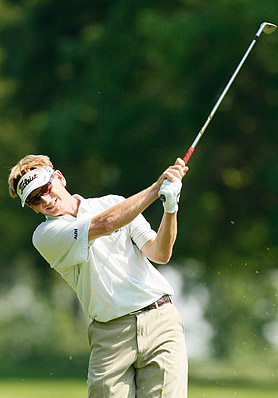A U.S. Open Q&A With Brad Faxon
March 3, 2010
Brad Faxon has played in each of the past three U.S. Opens held at Pebble Beach Golf Links, which will host the championship for the fifth time in 2010. The 48-year-old Faxon is also one of the most thoughtful players on the PGA Tour in analyzing course design and setup. He shared his thoughts with www.usga.org about heading back to the Monterey Peninsula in June.
Do you think players can glean much from the AT&T and apply it four months down the road in the U.S. Open?
 |
PGA Tour veteran Brad Faxon has played in each of the last three U.S. Opens conducted at Pebble Beach. (John Mummert/USGA) |
Faxon: Absolutely. Every time you come here, you learn something about the course, and there have been a lot of changes since the last U.S. Open. For example, No. 3 and No. 6. You’ll also see different lines off the tees you have to take on 8 and 11. The conditions will be very different in June, and you’ll see a lot more rough then. But we’ve seen a few bunkers added on holes like 2, and they changed the bunkering on 6. Also, 14 is a huge difference now. That’s become a very tough driving hole, on a hole where you used to just hit it as hard as you can. I think the course looks a lot better. I think it’s worthy of a U.S. Open.
How do you like the bunkering on No. 3?
Faxon: I always thought if you drove it through that fairway on 3 and you had a flyer lie going into that pin, you had no chance. Our players have a better chance of stopping the ball out of the fairway bunker. Not that the USGA’s sand is fun or easy to hit out of, but it’s made it a harder tee shot – especially in June, that fairway will be much firmer and it will be harder to stop the ball from rolling through the fairway, depending on the wind. And there’s another bunker now that you have to carry off the tee. That was always a hole you kind of tried to gamble and get it down to the left to keep your angle better. So it’s going to be harder.
How does the line differ on 6, 8 and 11?
Faxon: I think 6 is great. They’re making the hazard more in play for everybody. … The angle for both 8 and 11 is better from the left, and they’ve moved (the fairways) to the right. The greens open up from the left. So that’s the thing: the USGA has figured out how to make holes harder and how to make players upset before they even get there.
What’s the biggest difference in Pebble between February and June? Just the firmness? Or the rough?
Faxon: The course plays longer in February, but soft greens and soft fairways always make the scores go down, even if the course does play longer. I think that’s something the general public doesn’t understand. You might see a guy wallop his drive 350 yards during the U.S. Open – say, he gets it over the hill on 9 and the ball runs down 30 or 40 yards. People say, “Oh, this hole is too easy.” Well, in order to hold that ball from going in the right rough, you have to make sure you’re down on the left side and the line is correct.
So you know, a hole like 12, where [Tom] Kite made his great birdie putt across the green [in 1992], that’s because he was aiming out to the right and he had the long putt. That’s the kind of thing where I think Pebble Beach is so underrated – the difficulty of some of the pins. That Sunday pin on 12 isn’t tough in February, because you can just shoot it up in the air and the ball is going to stop wherever it hits. But come June when you’re playing to the 14th hole and the pin is front left, you’ve got to think, ‘Hey, how far do I want to leave this back? How much spin do I want to put on it?’ And if you hit a bad drive there and you’re hitting 5-iron into that green, you’ve got no chance.
How much harder do you expect the course to play in this year’s Open, compared to 2000?
Faxon: The U.S. Open setups are always so difficult because of firmness and rough. … I don’t think we really ever hit a penal shot out of the rough in February. You might have to take one more or one less club, but it’s never really a pitch-out. So it’s kind of paradise for a guy who can whale away and know the ball’s not going anywhere when it lands. I don’t think that’s the case come June. And the weather is always unpredictable in June, too. It could be cold or foggy or you could get that windy/sunny day. I’ll never forget the round [in 1992] when Tom Kite chipped in that shot on 7, and Gil Morgan blew a big lead. That can happen.
